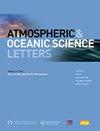用于ENSO预测的时空三维卷积神经网络模型:2020/21 La Niña条件的测试用例
摘要
许多耦合模式无法准确描述2020 - 2022年热带太平洋多年La Niña状况,这对实时El Niño-Southern涛动(ENSO)预测提出了新的挑战。然而,导致多年冷却的相应过程仍然没有得到很好的理解。本文利用再分析结果分析了热带太平洋海气相互作用对赤道太平洋中东部海温演变的影响,包括热带太平洋东南部强烈的距平东南风和相关的地下热异常。同时,建立了一个分时空(TS)三维卷积神经网络(CNN)模型,命名为TS- 3dcnn,用于预测2020/21年La Niña条件;将该模型与基于物理的中间耦合模型(ICM)的结果进行了比较。TS-3DCNN模型对2020-22年La Niña事件的预测结果表明,基于深度学习的模型可以在一定程度上捕获2年的La Niña事件,与IOCAS ICM相当;后一种动力模式成功地实时预测了2021年底Niño3.4海温异常,该异常从2021年初开始。在物理可解释性方面,设计并开展了敏感性实验,以确认异常东南风和地下温度场在维持2021年底第二年降温中所起的主导作用。将神经网络与ENSO事件的动态过程和机制有效结合的研究有望显著提高ENSO事件多样性的预测能力,这是改进ENSO事件多样性预测的潜在途径。摘要2020 - 22年间热带太平洋经历了持续性多年的拉尼娜事件,多数耦合模式都难以准确预测其演变过程,这为厄尔尼诺——南方涛动(ENSO)的实时预测带来了很大的挑战。同时, 目前学术界对此次持续性双拉尼娜事件的发展仍缺乏合理的物理解释, 其所涉及的物理过程和机制有待于进一步分析. 本研究利用再分析数据产品分析了热带东南太平洋东南风异常及其引起的次表层海温异常在此次热带太平洋海表温度(SST)异常演变中的作用,并构建了一个时空分离(时空)的三维(3 d)卷积神经网络模型(TS-3DCNN)对此次双拉尼娜事件进行实时预测和过程分析。通过将TS-3DCNN与中国科学院海洋研究所(IOCAS)中等复杂程度海气耦合模式(IOCAS ICM)的预测结果对比,表明TS-3DCNN模型对2020 - 22年双重拉尼娜现象的预测能力与IOCAS ICM相当,二者均能够从2021年初的初始场开始较好地预测2021年末El Nino3.4区SST的演变。此外,基于TS-3DCNN和IOCAS ICM的敏感性试验也验证了赤道外风场异常和次表层海温异常在2021年末赤道中东太平洋海表二次变冷过程中的关键作用。未来将神经网络与动力模式模式间的有效结合,进一步发展神经网络与物理过程相结合的混合建模是进一步提高ENSO事件预测能力的有效途径。Many coupled models are unable to accurately depict the multi-year La Niña conditions in the tropical Pacific during 2020–22, which poses a new challenge for real-time El Niño–Southern Oscillation (ENSO) predictions. Yet, the corresponding processes responsible for the multi-year coolings are still not understood well. In this paper, reanalysis products are analyzed to examine the ocean–atmosphere interactions in the tropical Pacific that have led to the evolution of sea surface temperature (SST) in the central-eastern equatorial Pacific, including the strong anomalous southeasterly winds over the southeastern tropical Pacific and the related subsurface thermal anomalies. Meanwhile, a divided temporal and spatial (TS) 3D convolution neural network (CNN) model, named TS-3DCNN, was developed to make predictions of the 2020/21 La Niña conditions; results from this novel data-driven model are compared with those from a physics-based intermediate coupled model (ICM). The prediction results made using the TS-3DCNN model for the 2020–22 La Niña indicate that this deep learning–based model can capture the two-year La Niña event to some extent, and is comparable to the IOCAS ICM; the latter dynamical model yields a successful real-time prediction of the Niño3.4 SST anomaly in late 2021 when it is initiated from early 2021. For physical interpretability, sensitivity experiments were designed and carried out to confirm the dominant roles played by the anomalous southeasterly wind and subsurface temperature fields in sustaining the second-year cooling in late 2021. As a potential approach to improving predictions for diversities of ENSO events, additional studies on effectively combining neural networks with dynamical processes and mechanisms are expected to significantly enhance the ENSO prediction capability.
摘要
2020–22年间热带太平洋经历了持续性多年的拉尼娜事件, 多数耦合模式都难以准确预测其演变过程, 这为厄尔尼诺-南方涛动(ENSO)的实时预测带来了很大的挑战. 同时, 目前学术界对此次持续性双拉尼娜事件的发展仍缺乏合理的物理解释, 其所涉及的物理过程和机制有待于进一步分析. 本研究利用再分析数据产品分析了热带东南太平洋东南风异常及其引起的次表层海温异常在此次热带太平洋海表温度(SST)异常演变中的作用, 并构建了一个时空分离(Time-Space)的三维(3D)卷积神经网络模型(TS-3DCNN)对此次双拉尼娜事件进行实时预测和过程分析. 通过将TS-3DCNN与中国科学院海洋研究所(IOCAS)中等复杂程度海气耦合模式(IOCAS ICM)的预测结果对比, 表明TS-3DCNN模型对2020–22年双重拉尼娜现象的预测能力与IOCAS ICM相当, 二者均能够从2021年初的初始场开始较好地预测2021年末 El Niño3.4区SST的演变. 此外, 基于TS-3DCNN和IOCAS ICM的敏感性试验也验证了赤道外风场异常和次表层海温异常在2021年末赤道中东太平洋海表二次变冷过程中的关键作用. 未来将神经网络与动力 模式模式间的有效结合, 进一步发展神经网络与物理过程相结合的混合建模是进一步提高ENSO事件预测能力的有效途径.

 求助内容:
求助内容: 应助结果提醒方式:
应助结果提醒方式:


